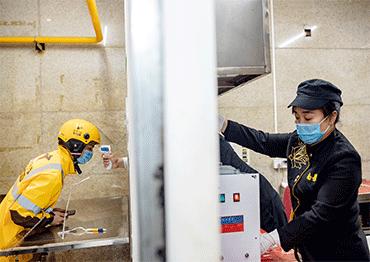Zhang Zheng, a scholar from the Guanghua School of Management at Peking University, said the numbers of young migrant workers have been declining since 2004. Data from the NBS shows that between 2011 and 2019, the proportion of migrant workers aged between 21 and 30 dropped from 32.7 percent to 23.1 percent. “Supply and demand for migrant workers is balanced, but there is higher demand for young workers,” Zhang said.
Factories are losing out to emerging service industries like delivery. “China’s services sector, which remains labor intensive, will play an increasingly larger role in absorbing labor. It’s an irreversible trend,” said Sun Wenkai, a research fellow at the National Academy of Development and Strategy at the Renmin University of China.
Cao Dewang, founder of Fuyao Group, China's largest vehicle glass manufacturer, partially blames young people choosing jobs as delivery drivers or security guards for manufacturing’s woes. “This has led to domestic manufacturing’s current dilemma,” Cao said during a 2019 interview.
Pan Jigang from Cosmo Lady said there is a general shortage of skilled workers, particularly experienced technicians. His company is offering over 10,000 yuan (US$1,428) a month and is still struggling to fill positions.
Chen Bin, 33, used to be a paint sprayer at an auto factory in Baoding, Hebei Province. Over four years, his monthly salary grew from 3,500 (US$500) to 5,000 yuan (US$714). “Pay increases were too slow and I couldn’t make ends meet,” Chen said. In July 2018, Chen became a delivery driver in Beijing. He earns between 8,000 (US$1,142) and 10,000 yuan (US$1,428) a month, the same as a senior auto mechanic at a car dealership back home.
Lack of experienced technicians in the job market has been a long-standing problem for China’s manufacturing. “The shortage has spread from eastern coastal areas to central and western regions. Atfirst it was seasonal, but now it is a regular phenomenon,” Sun said.
While there have been calls for workforce training to fill the gap, technical jobs still cannot attract younger people. Compared to courier and food delivery drivers, which offer similar wages and require little training, vocational jobs take more up-front investment. They seem more risky.
Technical skills are often highly specialized for a particular industry, which makes them less viable on the wider job market. The risk increases as technologies develop more quickly. Workers must not only consider market demand for such skills but also their life span.
“Some companies may pay a lot more for experienced technicians, but it is usually on unstable terms: How long the contract lasts depends on their needs,” said Zhang, adding that more technical school students turn to other professions after graduation. “That is why there are never enough technicians.”
“If businesses would offer more on-the-job training and job security, technicians might be more reluctant to leave. But in reality, not all manufacturing companies can do this,” Zhang said.
“Overall, manufacturing’s young labor force is shrinking. Besides income, young people are increasingly considering how they feel about a job, whether it brings respect, and their work environment. Factories need to figure out how to improve these factors if they want to keep young workers,” Sun said.

 Old Version
Old Version


